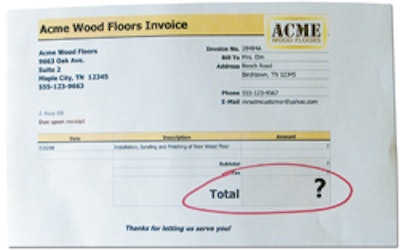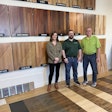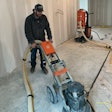
I wish I could say I started costing jobs from day one, but sometimes you stick with the way you were trained, or you honestly think you're making what you should be, and you really don't examine if you are doing it correctly. I've met a lot of intelligent people who still don't cost their jobs, and that's a bad decision in today's tight economy. You can go with your gut and gamble sometimes, but eventually that is going to fail you, and you're going to wish you had a more concrete method for calculating what you charge for your work in order to make a profit. With technology becoming more user-friendly, there's no excuse not to take advantage of spreadsheets and other software that can help you organize your business. Even so, costing a job can be intimidating to a lot of contractors. The bottom line is you have to know if you're making money on the job or not. The following is what I found to be most effective for our contracting company.
Material Costs
Let's start with a basic installation. The first thing is to determine the costs of your material (the wood). I like to get what I call a "fully loaded materials cost." This bundles the price for the wood, the cutting waste and the tax paid on the wood all into one number. For cutting waste, most contractors typically use 5 to 10 percent. If the price of the wood itself is $3 a square foot, and you add a 5 percent cutting allowance, your materials cost so far is $3.15 (0.05 x $3 = $0.15). To add tax, let's assume you use 8 percent tax at the point of purchase. Multiply 8 percent (0.08) by $3, which is $0.24, + $3.15 = $3.39 for a fully loaded material number per square foot.
Some contractors don't load their materials number. Instead, they just factor it into the square footage of the job. For example, if the job is 1,000 square feet, and the cost of the material is $3, they factor in 5 percent of the cutting waste, bringing the footage to 1,050, and 8 percent for tax, which is 80 feet, and adding it up to charge the homeowner $3 a square foot as though the job consisted of 1,130 square feet.
Labor Costs
The next thing is your labor expenses. Since our industry charges almost everything in square footage, you need to find out how much you pay your guys in terms of square feet. This takes some trial and error to evaluate how your employees work. Also, you need to determine the time that is included in your employees' pay. Do you pay them when they get to the job site, or do you pay them for that additional hour it takes to drive out to the suburbs for that project? Either way, it's important to stay consistent in costing labor.
Let's say you pay two guys $20 an hour each for actual installation work; that's $40 an hour you're paying. Then let's assume together they can do 300 square feet of straight-lay flooring in an 8-hour day: $40 x 8 = $320.
Take this total, and divide it by the square footage to get the dollar amount per foot: $320/300 = $1.07.
This is basically taking an hourly factor and converting it into square feet. You should do the same thing for sanding and finishing: Determine the average of how long it takes your crew to sand and finish 300 square feet of flooring, divide that into what you're paying them, and you have the labor cost per square foot for sanding and finishing. For costing a whole job, add all the labor numbers together.
Adding the Extras
The final part of the equation is determining your cost for sundries used on the job. This consists of everything you're going to use, which needs to be determined on a per-job basis: screws, edger discs, sanding belts, buffer screens, pads, rags, stain, filler, finish— everything you know you will be using, right down to nails. This number will fluctuate for each job, and it can be difficult to determine since these items are moving targets, but you really should have a close estimate of how much of each material you use. You could drive yourself crazy trying to figure out how many edger discs you'll use per square foot, but you can estimate how long a box lasts and make some educated guesses about how many boxes you'll need for future jobs. Costing some sundries is just simple division. If a gallon of poly costs $20, and it covers 500 square feet, then it costs $0.04 a foot.
Markup vs. Margin
Take all your sundry items, add them together, add that number onto your labor costs, and then add that total onto your fully loaded materials cost. Let's say you get an estimate of $6 a square foot. Now, here's where we try to make a profit. It's important to know the difference between markup and margin. Markup is the amount of money added to the cost of a product or a service. Margin is derived from profit divided by the selling price. Let's say we sell this job, which costs $6 a square foot, for $10 a square foot. There's a $4-persquare-foot profit, so you take $4 and divide by $10, which is 0.4, or 40 percent gross margin.
What's vital here is to have someone who knows your financial situation tell you what percentage of gross margin you should be shooting for in order to make a decent profit. A good accountant can work with you to get a number to multiply your cost per square foot on a job so you reach your target grossmargin profit. If you're aiming for a 40 percent margin, and in the past you sold a job costing $6 per square foot for $10, and this gave you a 40 percent margin, then you divide 10 by 6 to get a multiplier: 1.66. This is the number you will use on every job from here on out, as long as it continues to make you profitable.
Say you have another job that costs you $6 a square foot. You multiply $6 by 1.66 to get $9.96—rounding up, that's $10. To check to make sure you will be making your 40 percent, subtract your cost from your selling price: ($9.96 - $6 = $3.96).
Then, divide that number by the sales price: ($3.96 / $9.96 = 0.39 or 0.4, which is 40%).
A lot of guys do this incorrectly, thinking that if their cost is $6, and they want to add 40 percent margin, they can hit the percent key on their calculator and get $8.40. $8.40 minus $6 is $2.40, and $2.40 divided by $8.40 is 0.285—only a 28.5 percent gross profit. Margin comes from 40 percent of your sales, not 40 percent of your costs.
Review the System
There are several other things you have to do to make this system work for you. First, always go back and examine how your projected costs compared with your actual costs, and if you actually did produce the accurate gross profit on the job. If things don't add up, you need to examine where you lost it. Did you use more adhesive than you thought you would? Did your guys take longer to complete the amount of flooring? Use this information to modify your formula in the future in order to produce that gross margin you need to be successful.
Be consistent and use this method on every job. Once you get in the habit of using this costing method, you can apply it to any project, no matter how complicated. It may take extra time and effort at first, but it will pay dividends that show up on your bottom line.































